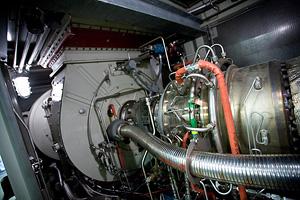September 8, 2008
AMHERST, Mass. — When Amherst College students returned to their alma mater last week, they may have noticed what Jim Brassord, director of facilities and associate treasurer for campus services, calls a “big green reminder of our commitment to the environment”: Solar panels on Mayo-Smith House, one of the most visible residence halls on campus located at the corner of Route 9 and 116 in Amherst. The panels, which will provide the building with 60 percent of the heat needed for its hot water, are one of several new initiatives focused on campus sustainability at the college.
 The 1250-kW jet engine that powers Amherst’s co-generation plant |
Here are just a few other ways Amherst continues to conserve and support the sustainable use of natural resources:
• Embracing co-generation—As of this past spring, the college began heating the campus through the environmentally efficient system of co-generation; Amherst’s set-up now consists of a 1250-kilowatt gas turbine generator that generates electricity as well as heat for steam that is then used to satisfy campus heat loads and keep boilers off-line. The system supplies approximately 50 percent of the college’s peak electrical load, 67 percent of the annual electricity usage and 30 percent of campus heating needs. And it’s clean, too: The carbon reduction will equal more than 22,000 tons of carbon dioxide or approximately 20 percent of Amherst’s greenhouse gas footprint. (To learn more about the system, check out the co-gen Web site.)
• Composting—This fall, dining services at Amherst begins its participation in a composting program. Through the initiative, the college is working with a farmer in Vermont, who will compost approximately 25 percent of Amherst’s total waste stream a year.
• Serving and protecting in an environmentally friendly vehicle—Even Amherst’s police force is getting into the act. At the beginning of the month, the college became the first campus law enforcement agency to purchase a Vectrix—a zero-emissions, electric motorcycle—for patrol.
• Going to extra lengths to reduce energy usage—The college has also installed a computerized system monitoring light in the athletics facilities, which consume a particularly high amount of energy. The investment, said Brassord, will pay for itself in energy savings in less than a year and a half.
“Some of these measures may seem smaller compared to others, but we are deeply committed to sustainability and we are really striving to set an example of responsible stewardship everywhere on campus,” said Brassord. “By establishing such institutional policies and practices that minimize our environmental impact, we also send a clear message to our students: Collectively and individually, we must be committed to conserving our resources.”
For more information about all the ways Amherst is committed to sustainability, go to the Green Amherst Web site.
###